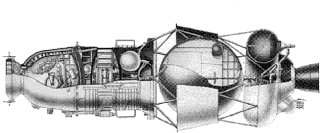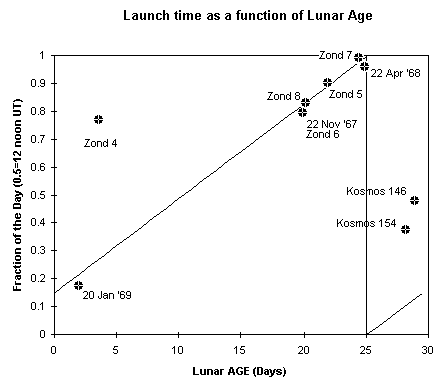
| Spacecraft | Launch date | Launch time
(UT) |
Incl.
(deg) |
Perigee
(km) |
Apogee
(km) |
Period | Signals on
(MHz) |
|---|---|---|---|---|---|---|---|
| Kosmos 146 (7K-L1 no.2P) | 10 March 1967 | 11:30:32.8 | 51.44 | 177 | 296 | 89.20 | 20.008 |
| Kosmos 154 (7K-L1 no.3P ) | 8 April, 1967 | 09:00:32.7 | 51.3 | 183 | 223 | 88.50 | 19.995 |
These flights have been regarded
as tests of the Zond complex involving the firing of the fourth stage of
the UR-500 rocket to put the L1 spacecraft into an elliptical trajectory
to test high speed re-entry. Considerable disagreements exist as to what
happened to these flights. Did they fail, and if so, why? The picture blow
shows what these space vehicles would have looked like in earth orbit.


"...Surprisingly, the original L-1 flight plan, discussed during a 24 December 1966 meeting of the L-1 state commission, envisaged a dual launch scenario, It was decided to launch the L-1 unmanned on Proton and subsequently send up a two-man crew on a Soyuz spacecraft, the reason being that the three-stage Proton rocket (UR-500K) earmarked to launch L-1 and its Block-D escape stage hand not flown at the time. Following docking with the L-1/Block-D combination in Earth orbit the crew would space walk to the L-1, following which the Block-D would boost the L-1 to the Moon and the Soyuz would return to the earth unmanned. It was not until early June 1967, by which time the UR-500K had made two successful launches, that this plan was abandoned in favour of a single launch scenario on Proton...."
Astronomia, Kosmonavtika (Znaniye), December 1991 : "[The Kosmos-146 launch], which used the first four-stage UR-500K with a Block-D upper stage, was meant to test the upper stage. The L-1 vehicle was launched in a simplified version. During the flight two firings were conducted of the Block-D's liquid rocket engine."
Kamanin diaries 11 March 1967 : "Yesterday the Soviet Union launched the first L-1 vehicle (in the press it has been called Kosmos-146). All engines of the UR-500K functioned beautifully and the ship was boosted to second cosmic velocity and sent to the Moon. This is where the experiment ended, but the important thing is that this was the fourth successful launch of the UR-500K out of five attempts. One similar launch of an L-1 vehicle is envisaged by the programme to prepare for a lunar fly-around".
(This entry could represent a problem : it would indicate that the Block-D was fired fairly early in the mission and that Kosmos-146 did not coast in low orbit for more than a day. But, on the other hand, if the Block-D second firing occured at midday on the 11 th, this event would have been included in Kamanin's diary for that day, if Kamanin wrote the diary late at night every day).
Novosti Kosmonavtiki 18-31 Dec 1993 : an article about engines of the Kosberg bureau by Timothy Varfolomeyev : ".... The first flight test of the DU 8D49 as a third stage engine for the 8K82K booster took place on 10 March 1967. The rocket placed into a highly elliptical orbit a prototype of a manned circumlunar vehicle (7K-L1P), named Kosmos-146 by TASS".
Novosti Kosmonavtiki supplement (June 1995) (list of man-related launches) : Kosmos-146 (7K-L1P) : first unmanned test flight of a circumlunar vehicle. Tests of the Block-D, ensuring the ship's boosting to the Moon.
Kamanin diaries 6-9 April 1967 : First Kamanin describes how he and a group of chief designers and ten cosmonauts headed by Leonov and Popovich arrived at the cosmodrome on 6 April. The following day they visited Complex 92 to take a close look at the Proton rocket. The launch took place "under clear blue skies" on 8 April at 12.00.08 Moscow time. He then goes on : "All three stages of the rocket and the Block-D upper stage worked fine and lunar ship nr. 2 (Kosmos-154) was successfully placed into Earth orbit. Forty minutes later the members of the State Commission and the chief designers met in Area 2 in Kirillov's office. Everyone congratulated Chelomei with the success. But placing the ship into orbit was only the first step. In a day's time the Block-D has to be fired again to send the ship to the Moon. Although operations like this have been successfully carried out more than ten times [he must be referring to the Molniya's Block-L], it is too early for Mishin, who's responsible for the Block-D, to declare victory".
On 9 April he goes on : "Yesterday we were all happy with the successful launch of the UR-500K with the L-1 vehicle, but today, due to Mishin's fault, we experienced the bitter taste of defeat : the Block-D did not ignite and we cannot send the ship to the Moon. The L-1 capsule has an automatic device which after the first firing of the Block-D casts off the [ullage motors]. During the launch of lunar ship nr. 2 this automatic device should have been switched off, because it had been decided to fire the Block-D twice : first to put the complex into Earth orbit and then to boost it to second cosmic velocity. The orders to switch off the device had been given by Tyulin, but due to the negligence of Mishin they were not carried out. The ship went into orbit with the automatic device switched on and the latter did its work "faultlessly" after the first burn of the Block-D".
Novosti Kosmonavtiki supplement (June 1995) (list of man-related launches) : Kosmos-154 (7K-L1P) : unmanned test flight of circumlunar vehicle. Tests of the Block-D did not take place because of a mistake during preparations
| It seems that Kosmos 146 and 154 were launched to test the Block-D trans-earth injection burn and that this may have worked fine for Kosmos 146, but not for Kosmos 154. Judging from Kamanin's comments, there were no further plans for re-entry tests with the L-1. It also seems that the Block-D escape burn was scheduled to occur one day into the mission to demonstrate support for the scenario in which the crew of the L-1 would have been launch in a Soyuz to dock with the L-1/Block-D combination! Did anyone in the West pick up evidence of the L-1 in the elliptical orbit, and how elliptical was it?? |
![]()